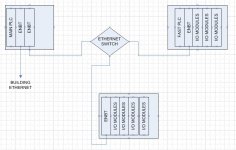Paul351W
Member
I am setting up a new system consisting of 3 racks, one Panelview Plus 1500, and two processors.
One processor will act as the master control for a test site, with the second processor on a remote rack running high speed controls. The other rack only contains a 1756-ENBT module and I/O modules to serve the master PLC.
I am passing produced and consumed tags between the two processor racks and I have set up a heartbeat signal between the two so I can detect a connection loss, but how do I detect a communication loss with the remote rack? I've been searching the user manuals and help files for a couple hours and haven't found anything yet.
I want to shut the whole test stand down if communication is lost between any of the devices on the Ethernet network.
One processor will act as the master control for a test site, with the second processor on a remote rack running high speed controls. The other rack only contains a 1756-ENBT module and I/O modules to serve the master PLC.
I am passing produced and consumed tags between the two processor racks and I have set up a heartbeat signal between the two so I can detect a connection loss, but how do I detect a communication loss with the remote rack? I've been searching the user manuals and help files for a couple hours and haven't found anything yet.
I want to shut the whole test stand down if communication is lost between any of the devices on the Ethernet network.




